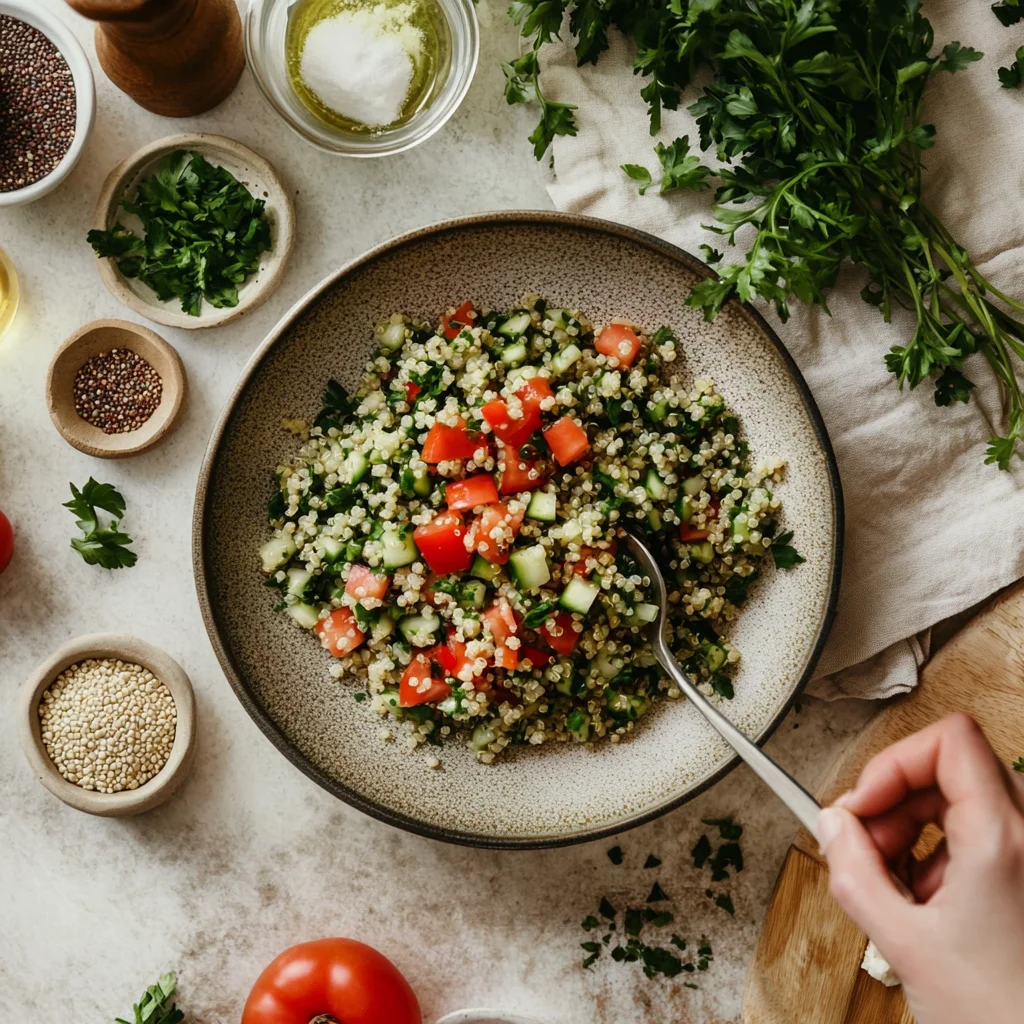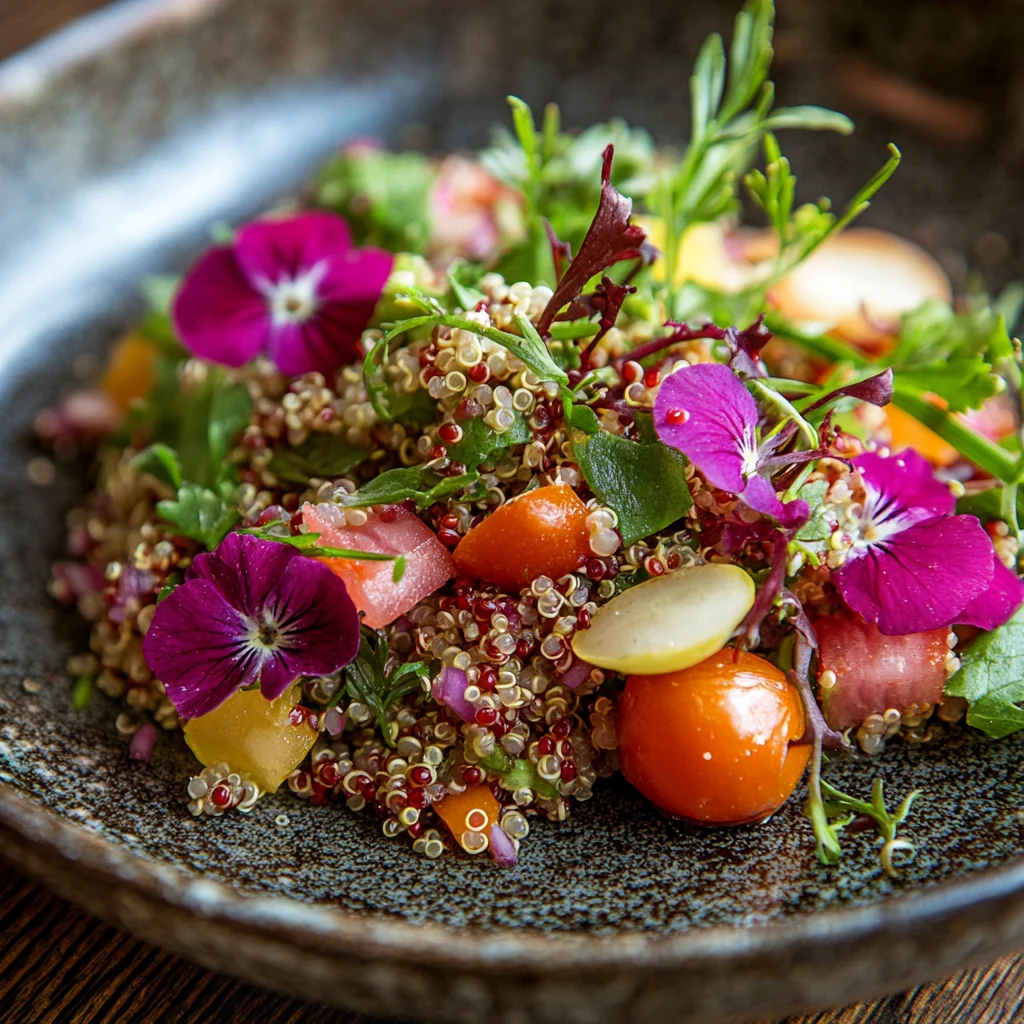 Pin it
Pin it
This fresh, vibrant quinoa tabbouleh transforms traditional Mediterranean flavors with a protein-packed twist. I've brightened the classic parsley-based salad by substituting bulgar wheat with fluffy quinoa for a nutritious upgrade that maintains all the beloved zesty flavors of the original.
I first made this recipe when hosting a summer gathering in my backyard. The bright herbs and tangy lemon dressing earned so many compliments that it's now my signature contribution to every potluck and family picnic.
Ingredients
- Fresh parsley: Two full bunches create the vibrant green base that defines tabbouleh
- Fresh mint: Adds a cooling element that balances the sharpness of lemon and garlic
- Green onions: Provides mild onion flavor without overpowering the delicate herbs
- Garlic: Just one clove adds dimension without dominating
- Extra virgin olive oil: Use the best quality you can find as it carries the flavor throughout
- Fresh lemon juice: Always use freshly squeezed for the brightest taste
- Ripe tomatoes: Choose firm but ripe tomatoes for the perfect juicy texture
- Cucumber: Adds refreshing crunch and helps balance the herbs
- Quinoa: The protein rich substitute for traditional bulgur wheat
- Salt and pepper: Simple seasonings that bring everything together
Step-by-Step Instructions
- Prepare the quinoa:
- Cook quinoa according to package directions until fluffy and tender. This typically involves rinsing thoroughly first, then cooking with a 1 to 2 ratio of quinoa to water. Allow to cool completely before mixing with other ingredients for best texture.
- Process the herbs:
- Place washed and destemmed parsley, mint, green onions, garlic, olive oil and lemon juice in food processor. Pulse until finely chopped but still maintaining some texture. If you prefer a more rustic presentation, chop everything by hand instead of using a processor.
- Combine all ingredients:
- In a large mixing bowl, gently fold together the processed herb mixture with diced tomatoes, cucumbers, and cooled quinoa. Take your time with this step to ensure even distribution without crushing the delicate ingredients.
- Season and finish:
- Taste the mixture and add salt and pepper according to preference. The flavors will develop as the salad sits, so consider starting with less salt than you think necessary. Drizzle with additional olive oil just before serving for a beautiful sheen and flavor boost.
 Pin it
Pin it
My absolute favorite part of this recipe is watching people who claim they don't like parsley devour this salad. The secret is in the balance of ingredients. When my daughter first tried it at age six, she declared it tasted like "summer in a bowl" and I cannot think of a more perfect description.
Make Ahead Tips
This tabbouleh actually improves with time as the flavors meld together. You can prepare it up to two days in advance and store in the refrigerator. The acids in the lemon juice help preserve the bright green color of the herbs. If making ahead, consider reserving a bit of fresh herbs to sprinkle on top just before serving for an extra burst of color and flavor.
Perfect Pairings
Quinoa tabbouleh makes an exceptional side dish for grilled meats, especially lamb or chicken. It also pairs beautifully with Mediterranean mains like falafel, hummus, or baba ganoush. For a complete meal, serve alongside warm pita bread and a dollop of Greek yogurt. In summer months, I love serving it with grilled vegetables and a simple protein for a refreshing dinner.
Ingredient Substitutions
If quinoa isn't your preference, you can return to the traditional bulgur wheat or try other grains like couscous or farro. For those watching their oil intake, reduce the olive oil by half and increase lemon juice slightly. Red onion can replace green onions for a more assertive flavor. In winter months when fresh tomatoes lack flavor, substitute with halved cherry tomatoes or even roasted red peppers for a different but complementary taste profile.
Cultural Context
Traditional tabbouleh from Lebanon and Syria features parsley as the star, with bulgur wheat playing a supporting role. This quinoa version honors those roots while incorporating modern nutritional preferences. In Middle Eastern cuisine, tabbouleh is typically served as part of a mezze spread, alongside other small dishes. The bright acidity and herb forward profile is designed to cleanse the palate between richer dishes.
 Pin it
Pin it
Frequently Asked Questions
- → Can I use other grains instead of quinoa?
Yes, traditional tabbouleh uses bulgur, but you can substitute with couscous or millet for similar results.
- → How do I keep the herbs fresh and vibrant?
Always wash and dry the herbs properly before chopping, and keep them refrigerated until use for maximum freshness.
- → Can I make this dish ahead of time?
Yes, the flavors meld wonderfully over time. Prepare a day in advance but add the tomatoes and cucumber just before serving to avoid excess moisture.
- → What can I pair with this tabbouleh?
Serve as a light side dish alongside grilled chicken, fish, or falafel. It also pairs well with pita bread and hummus.
- → Is this dish gluten-free?
Yes, using quinoa instead of bulgur makes this version gluten-free.